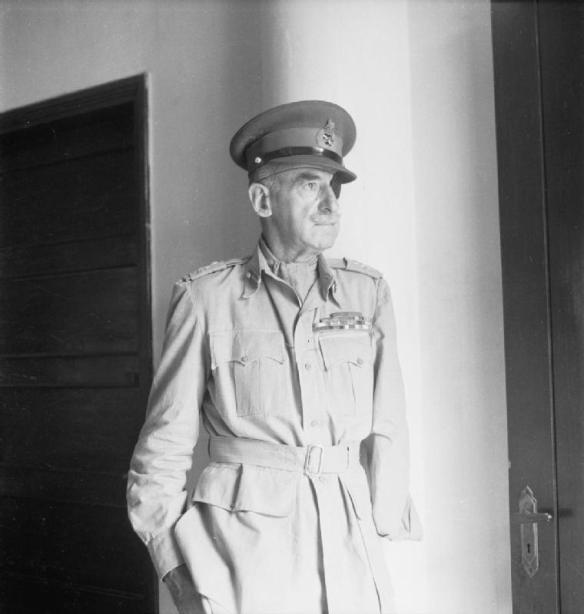Adrian Carton de Wiart during World War II, photographed by Cecil Beaton
(1880–1963), VC, KBE, CB, CMG, DSO
Born in Brussels, brought up in Cairo and educated at the Oratory School, Edgbaston, Carton de Wiart abandoned his studies at Oxford to enlist in Paget’s Horse in 1899. Wounded in South Africa, he ended the Boer War as a subaltern in the 4th (Royal Irish) Dragoons. Seconded to the Somali Camel Corps in 1914, he was wounded in the campaign to track down Mahomed bin Abdillah Hassan, the ‘Mad Mullah’, and, admitted to the DSO, was invalided home the next year.
Having had his left eye removed, Carton de Wiart rejoined his regiment in France. But he was to return wounded so often to the same hospital that, it is said, silk pyjamas with his name on were reserved for him (Sheffield in Keegan, 1991, 325). Losing his left hand in 1915, he was awarded the VC in 1916, only to be wounded again. He was, by war’s end, a brigadier and a celebrity in the army. His eye-patch and empty sleeve invited the inevitable nickname, ‘Nelson’.
Appointed second-in-command, and later head, of the British Military Mission to Poland in 1919, Carton de Wiart witnessed a good deal of military activity but was unable to exert much political influence. However, he fell in love with the place and its people sufficient to be loaned an estate near the Soviet border and settle there after resigning his commission in 1924.
His life as a Polish country gentleman, ‘happily shooting duck’ (DNB), was interrupted in 1939. Again made head of the British Military Mission, he could do nothing save evacuate his staff and their families from Warsaw to Romania. Back in England, although in his sixty-first year, he was appointed to command the 61st (Territorial) Division based in Oxford, while in April 1940 he was chosen to command MAURICEFORCE for the campaign in Norway. Landed at Namsos with a small staff, supposedly to co-ordinate a pincer-attack on Trondheim, it was not long before Carton de Wiart realized that German air superiority rendered his position untenable and recommended evacuation. Had a less famously brave man made the request, it might not have been listened to. As it was MAURICEFORCE was evacuated with very few casualties.
Norway was Carton de Wiart’s last active command. Appointed Head of the British Mission to Yugoslavia in April 1941, his aircraft crashed off North Africa en route and he was taken prisoner. Imprisoned near Florence and thrown into the company of other captured British senior officers, he proved himself ‘a delightful character [who] must hold the world record for bad language’ (Ranfurly, 1994, 123). Escaping, only to be re-captured, his Italian captors sent him to Lisbon in August 1943 hoping that, as an unwitting intermediary, Carton de Wiart might secure favourable armistice terms.
In one of his more eccentric decisions Churchill had Carton de Wiart promoted lieutenant general and made him, less than a month after his return to Britain, his personal representative to the Chinese generalissimo, Chiang Kai-shek. It was a position requiring more tact and delicacy that Carton de Wiart possessed, especially as, never having been to China, he imagined it full of ‘whimsical little people . . . who . . . worshipped their grandmothers’ (Carton de Wiart, 1950, 235). Developing a fondness for Chiang and his wife, and disagreeing with Mountbatten when he was supposed to be liaising with him, he appeared before the cabinet in January 1945, only to deliver a report on the China situation that lasted a full six-and-a-half minutes.
But Carton de Wiart’s inadequacies as a diplomat tended to enhance his reputation as a man of action and inspired leader of men. Regarded with enormous affection as a beau sabreur (French, 1991, 1200), almost a throwback from a previous age, he was, it is said, the model for Evelyn Waugh’s Ritchie-Hook character in Men at Arms.
Finally retired in 1947, Carton de Wiart wrote his entertaining memoirs, Happy Odyssey and, a widower in 1949, married again in 1950. Living in the west of Ireland and still waging his personal war against the local duck population, he received honorary degrees from Aberdeen and Oxford Universities.
